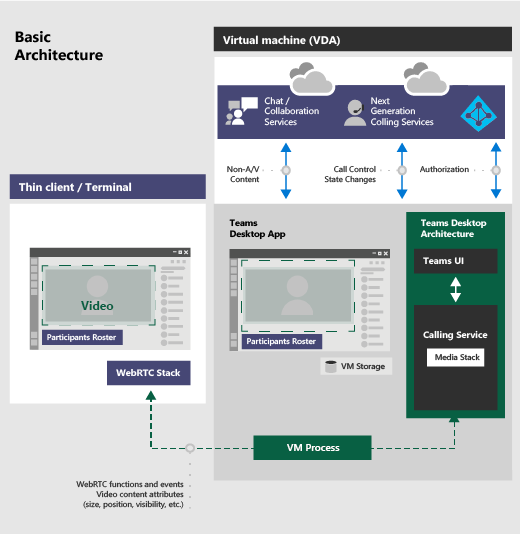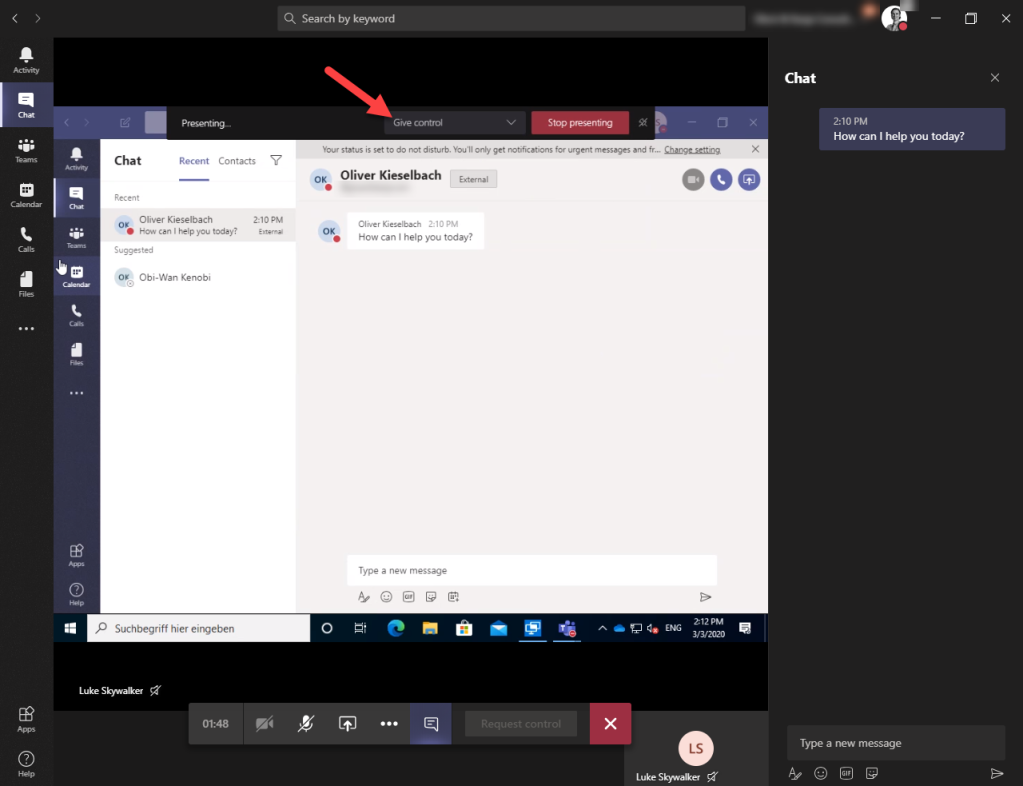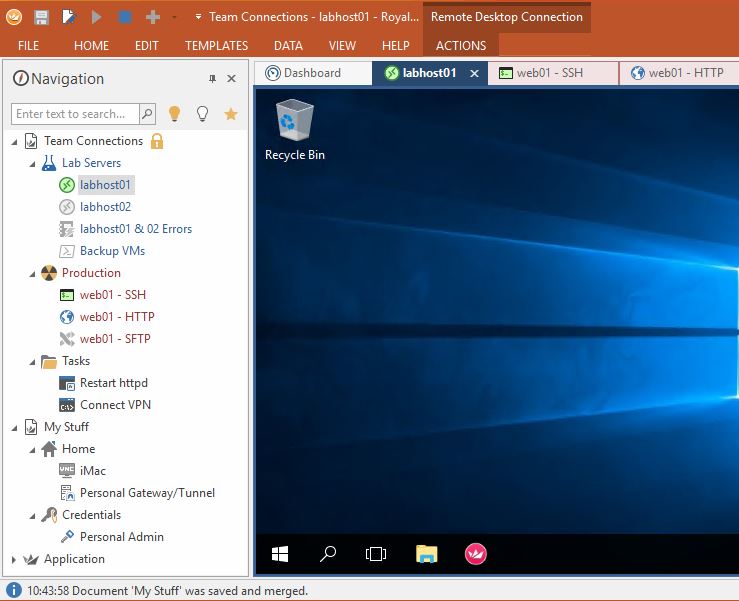- Enable Remote Desktop
- Remote Control Through Microsoft Teams
- Remote Desktop Via Microsoft Teams Download
- Remote Desktop And Teams
Some of these considerations can be addressed using Microsoft Remote Desktop Services to act as a gateway to grant access to remote desktop systems. The Microsoft Remote Desktop Services gateway uses Secure Sockets Layer (SSL) to encrypt communications and prevents the system hosting the remote desktop protocol services from being directly. About eight months ago, I came across a tool in the repository called Remote Desktop Connection Manager ('RDCMan' for short) written by Julian Burger, one of our principal developers on the Windows Live Experiences team. RDCMan is a central place where you can organize, group, and manage your various Remote Desktop connections. Use the Microsoft Remote Desktop app to connect to a remote PC or virtual apps and desktops made available by your admin. With Microsoft Remote Desktop, you can be productive no matter where you are. Sep 04, 2020 TM221283, Microsoft Teams, Last updated: September 8, 2020 9:42 AM Start time: September 1, 2020 2:01 PM Status Service degradation User impact Users who are given control by a presenter during a Microsoft Teams meeting are unable to control the screen. Teams across the globe are moving to remote work. Microsoft aims to keep teams connected while they work apart by making Microsoft Teams available to as many people as possible. Teams allows you to chat, meet, call, learn, and collaborate all in one place. Sign up and start using Teams for free today, plus read on for tips for working from home.
Collaboration and communication are aspects of the workplace that are always challenging, but are particularly difficult during this time when so many people are working from home. Keeping in contact with co-workers while you are physically distant from them is no easy task, and attempting to work together to produce meaningful work can be difficult when you must go back and forth multiple times just for one file or project. Using Microsoft Teams can be a great solution.

Microsoft Teams is a simple, yet robust solution based in the cloud, making collaboration tools available from any internet connection. Teams delivers features that enable your business users to remain empowered to get their work done even while working remotely.
The sheer number of meetings happening in Microsoft Teams is increasing exponentially. Microsoft is seeing an increase from 900 million on March 16, to 2.7 Billion on April 9th reflecting a 200% increase. People are engaging twice as much during weekly calls and meetings using video, which grew from 21% to 43%, from March 2 to March 31.
Using Microsoft Teams for Remote Work
A Shared Workspace
The Teams and Channels within the application allow for cloud-based file storage with global accessibility and real-time collaboration. Setting up your first Team is fairly simple. All you have to do is add the users who need access to the team, and you can start collaborating immediately. Within each Team, it is easy to stay organized by creating Channels within the Team. For example, NetGain has a Marketing Team, which has channels within it for several categories, from blog posts just like one you’re reading now, to in-person events we host. Within each channel on a Team there is a place for files to be kept, a discussion board where you can tag specific individuals, a place to create task lists, and many more functions. You can integrate other applications into Teams as well like PowerBI, Adobe Creative Cloud, and more.
Editing Files
Teams allows you to create or upload Microsoft Word, Excel, and Powerpoint files within the application. You can keep everything organized and edit it just as you would on your desktop, but with the added bonus of real-time collaboration. Whether you are working on a spreadsheet or a slide deck, any Team members can work to edit the document at the same time. No more sending emails back and forth for just a few simple changes – using Microsoft Teams you can make edits, or watch others edit, in real time. To me this is a huge benefit as I’m working with team members. Since in-person meetings and collaboration are not possible while working remotely, using teams file editing capabilities is a great solution to keep users in communication easily.
Online Meetings, Calling & Video Conferencing, and Chat
Sometimes it takes more than the file sharing tools available to edit documents, or complete other tasks, and you need to communicate in more detail. Teams has functions to facilitate this as well. With both a chat and call feature that includes video and screen sharing, you can send a quick message to a colleague, or spend time in a one-on-one discussion. Screen sharing is especially helpful while working remotely, as you can show your colleagues exactly what you are seeing, even though they can’t physically walk over to your computer screen anymore. In addition to these features facilitating remote work, they are also a good way to keep in touch with colleagues during this time. Remote work can be a bit isolating, but using the Teams chat feature allows you to quickly check in, and video conferencing means you can hold company-wide virtual coffee breaks or happy hours to keep everyone feeling positive and maintain morale. Video conferencing even has fun custom backgrounds to keep things light!
Calendar
If you use Microsoft Outlook, your calendar will be integrated with the Teams calendar automatically. You can also set up meetings using the call feature mentioned above, similar to Cisco WebEx, Skype, or Zoom calls.


Enable Remote Desktop
Security
Chat messages, video, audio, and any files within Microsoft Teams are all encrypted. Users must utilize multi-factor authentication to log into Teams, after they have been approved by your internal I.T. team for access. Using Microsoft Teams means that your information will be secure while collaborating with ease.

Remote Control Through Microsoft Teams
As you can see, there are many great features Microsoft Teams provides to foster quick, real-time collaboration that is especially needed during this time of increased remote work. However, it’s also extremely useful at any time for organizations with multiple offices, or those that need more robust collaboration tools beyond email.
Remote Desktop Via Microsoft Teams Download
Many companies are offering assistance as businesses adjust to working from home when that may not have been an option in the past. Due to the global pandemic, Microsoft is currently offering a simpler version of Teams for free to aide in business collaboration. If you would like assistance setting up the full version of Teams for your business, contact NetGain today.
Remote Desktop And Teams
Use Remote Desktop on your Windows, Android, or iOS device to connect to a Windows 10 PC from afar.
Set up the PC you want to connect to so it allows remote connections:
Make sure you have Windows 10 Pro. To check, go to Start > Settings > System > About and look for Edition. For info on how to get it, go to Upgrade Windows 10 Home to Windows 10 Pro.
When you're ready, select Start > Settings > System > Remote Desktop, and turn on Enable Remote Desktop.
Make note of the name of this PC under How to connect to this PC. You'll need this later.
Use Remote Desktop to connect to the PC you set up:
On your local Windows 10 PC: In the search box on the taskbar, type Remote Desktop Connection, and then select Remote Desktop Connection. In Remote Desktop Connection, type the name of the PC you want to connect to (from Step 1), and then select Connect.
On your Windows, Android, or iOS device: Open the Remote Desktop app (available for free from Microsoft Store, Google Play, and the Mac App Store), and add the name of the PC that you want to connect to (from Step 1). Select the remote PC name that you added, and then wait for the connection to complete.

